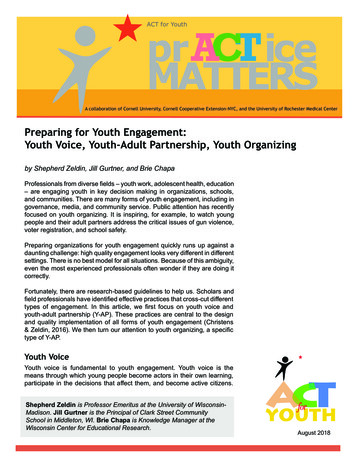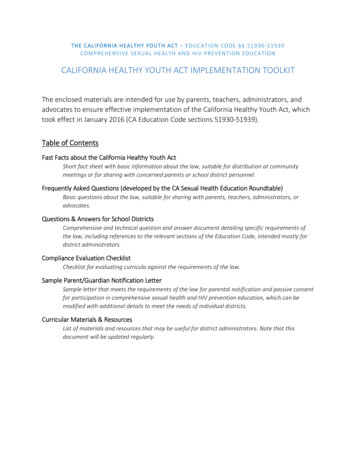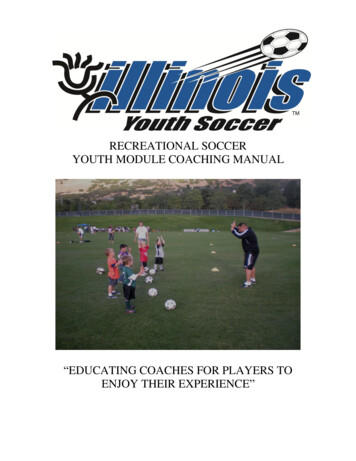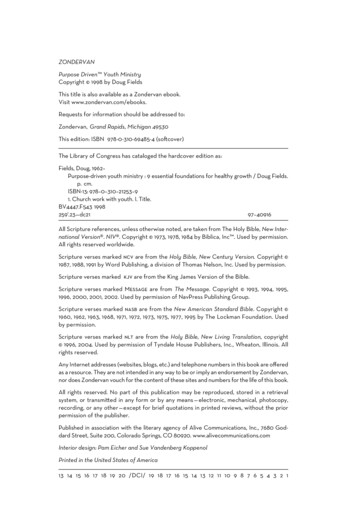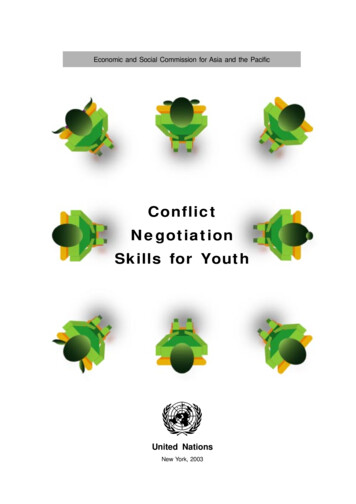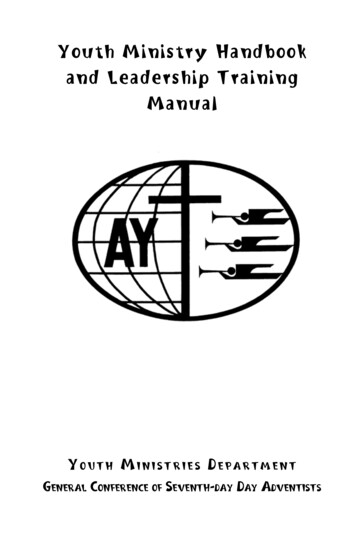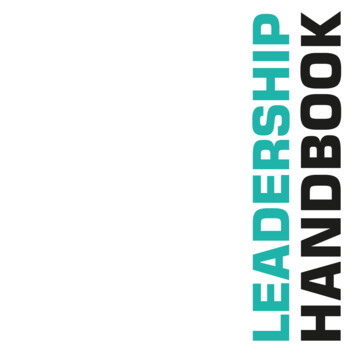
Transcription
From Childhood to Adolescence:Healthy Youth Development & Well-BeingPicture a Brighter Future for Oklahoma ChildrenChild Abuse Prevention Day Mini ConferenceApril 14, 2015Oklahoma City, OKCharlyn Harper Browne, PhD
The Center for the Study of Social Policy Nonprofit public policy, research, and technical assistanceorganization based in Washington, D.C. Work with state and federal policymakers and withcommunities across the country. Mission: promote strategies that produce equalopportunities and better futures for all children andfamilies, especially those most often left behind. Develop new ideas, conduct research, promote policysolutions, and provide technical assistance topolicymakers, administrators, researchers, andcommunity-based organizations.
CSSP’s Theory of Change Includes building protective factorsreducing risk factorsstrengthening local communitiesconnecting all of thisto systems changeand policy a fierce commitmentto equity acrosslines of race,ethnicity, andculture
CSSP’s DevelopmentalProtective Factors FrameworkYouth ThriveStrengthening Families1.Parental Resilience1.Youth Resilience2.Social Connections2.Social Connections3.Knowledge of Parentingand Child Development3.Knowledge of AdolescentDevelopment4.Concrete Support in Timesof Need4.Concrete Support in Times ofNeed5.Social and EmotionalCompetence of Children5.Cognitive & Social-EmotionalCompetence of Youth
Two New Reportswww.cssp.org
TheFrameworkDescribes how all youth and youngadults (ages 9-26) can besupported in ways that advancehealthy development and well-being and reduce the impact ofnegative life experiences, withparticular focus on youth receivingchild welfare services.
Purpose of the YT SessionTo provide an overview of the ideas and researchfrom the neurobiological, behavioral, and socialsciences that inform the evidence-base of the YTframework: Foundational ideas Research that informs the theoretical articulation ofthe YT protective factorsTo discuss the practical application of the YTframework
Foundational Ideas of the YT Approach1.Strengths-based perspective2.The biology of stress3.Resilience theory4.The Positive Youth Development perspective5.Focus on well-being6.The nature of risk, protective, and promotivefactors
FI 1: The Strengths-Based Perspective1. A strengths-based perspective is grounded in thebelief that all youth have strengths.2. Encourages shared-decision making.3. Does not eliminate the need to address barriers suchas poverty, abuse, neglect, and other hardships thatare very real and devastating for too many childrenand youth.4. Identifying and building upon a youth’s strengths isessential in implementing the Youth Thrive approach.
Youth StrengthsEmotional and behavioral skills that. . . create a sense of personal accomplishment contribute to satisfying relationships enhance one’s ability to deal with adversity and stress promote one’s personal, social, and academic or careerdevelopment
FI 2: The Biology of StressThe YT approach emphasizes, in order to forgerelationships and create environments that support thedevelopment of youth’s and young adults’ resilience, wemust be aware of: How adverse childhood experiences can haveimmediate, long-term, and enduring effects Differences in stressors and stress The nature of positive, tolerable, and toxic stress
The ACE StudyCategories of adverse childhood experiences1.2.3.4.5.6.7.8.9.10.Emotional abusePhysical abuseSexual abuseEmotional neglectPhysical neglectMother treated violentlyHousehold substance abuseHousehold mental illnessParental separation or divorceIncarcerated household member
Early Trauma and Later BehaviorAdverse Experiences Direct experience ofexposure to violence Child abuse, neglect,abandonment Accumulated burden ofeconomic hardship Parental substance abuse Parental depressionLater Impacts Hypersensitivity to stressors Problems with trust,autonomy, and initiative Difficulty interpretingemotional responses Patterns of intense,unstable relationships
Stressor vs. StressStressorsThe experiences that are perceived as challenging orthreatening as “stressors”StressThe biological and emotional responses to such eventsStress Response SystemA series of bodily changes—such as increased heart rate,blood pressure, and production of stress hormones—thatare automatically triggered by the brain when faced with achallenging or threatening experience
Classification of Stress ResponsesPositive StressModerate and short lived pressure (e.g., being immunized) that causesbrief increases in heart rate or mild changes in stress hormone levels.Positive stress is regarded as an important and necessary aspect ofhealthy development that occurs in the context of stable and supportiverelationships.TolerableSevere pressure that is buffered by supportive relationships that promotehealthy coping and mitigate the damaging effects (e.g., death of a lovedone). If left unchecked, tolerable stress can become toxic stress.ToxicStrong, frequent, prolonged adversity/trauma without thebuffering of adequate adult support (e.g., physical, sexual, oremotional abuse). Toxic stress disrupts brain development.National Scientific Council on the Developing Child. (2005). Excessive stress disrupts the architectureof the developing brain. Working Paper No. 3.
FI 3: Resilience Theory Resilience is a process & an outcome, not a personality trait Learned through exposure to challenging life eventsfacilitated by supportive relationships and environments(e.g., people, culture, institutions, conditions, policies) Resilience is contextual with respect to setting, point in time,culture, and social factors Resilience reflects a person’s pattern of positive adaptivebehavior in response to current or past risk factors oradversity Resilience results in personal growth and positive change
FI 4: Positive Youth Development Theory1. Identify and build on youths’ strengths2. Youth development is more than overcoming deficits and risk3. Provide access to caring people and safe places and institutions4. Provide services, opportunities, and supports5. Encourage youth to make informed decisions6. Build meaningful, respectful, sustained relationships7. Collaborate across community sectors
FI 5: A Focus on Well-Being Well-beingThe healthy functioning of children and youththat allows them to be successful throughoutchildhood and into adulthood 4 domains of child well-being identified by theAdministration for Children and Families: cognitive functioning physical health and development emotional/behavioral functioning social functioning
Well-Being Also Includes. . .Center for the Study of Social Policy: Must take into account the interplay betweena youth’s well-being and the parenting orcaregiving environment around them Attachment to a caring and reliable adult mustalso be included as part of the concept andrecommended actions to promote well-being
FI 6: The Nature of Risk & Protective FactorsDomains of the Social EcologySocietal ity itiesRelational FamilyPeersOthersIndividual StrengthsChallengesAdversitiesAdapted from the Centers for Disease Control and Prevention Social-Ecological Model:A Framework for Prevention
Risk, Protective, & Promotive FactorsRiskFactorsProtectiveandPromotiveFactors
Cumulative Protective & Promotive FactorsThe presence of multiple protective andpromotive factors is associated with adecreased likelihood of involvement inproblem behaviors.
YT Theory of Change Youth in general, as well as those at heightenedrisk for negative outcomes, have a greaterlikelihood of achieving healthy outcomes as aresult of experiences that support the buildingof the Youth Thrive protective and promotivefactors and the reduction of risk factors.
The YT Protective and Promotive FactorsThe Youth Thrive framework describes five interrelatedattributes and conditions that are simultaneously: Protective factors, i.e., they prevent or mitigate theeffect of exposure to risk factors and stressful lifeevents Promotive factors, i.e., they actively enhance healthydevelopment and well-being
YT Protective and Promotive FactorsYouth Resilience: Managing stress and functioning wellwhen faced with stressors, challenges, or adversity; theoutcome is personal growth and positive change.Social Connections: Having healthy, sustainedrelationships with people, institutions, the community,and a force greater than oneselfKnowledge of Adolescent Development: Understandingthe unique aspects of adolescent development;implementing developmentally and contextuallyappropriate best practices
YT Protective and Promotive FactorsConcrete Support in Times of Need: Understanding theimportance of asking for help and advocating for oneself;receiving a quality of service designed to preserveyouths’ dignity, provide opportunities for skilldevelopment, and promote healthy developmentCognitive and Social-Emotional Competence: Acquiringskills and attitudes that are essential for forming anindependent identity and having a productive,responsible, and satisfying adulthood
Protective & Promotive FactorsYouth Resilience
Resilience Much more than “bouncing back” The processes that enable youth to thrive inthe face of adversity Should result in positive growth and change
Youth Who Demonstrate Resilience Call forth their inner strength topositively meet challenges,manage adversities, heal theeffects of trauma, and thrive giventheir unique characteristics andcircumstances. Have a trusting relationship witha caring and competent adult whoprovides positive guidance andpromotes high expectations.
Protective & Promotive FactorsSocial Peers &IntimatePartnersOtherAdults
Youths’ Social Connections Healthy, sustained, supportive, caring relationshipswith family and other adults Healthy, supportive, caring relationships withpeers and close friends Physically and emotionally safe, stable, supportiveequitable environments Opportunities for constructive engagement infamily, school, community and socialinstitutions
Youths’ Sense of ConnectednessFindings from the National Longitudinal Study onAdolescent Health “revealed the importance offeeling a strong sense of connectedness: toparents, to family, to other pro-social, supportiveadults, as well as the protective effects of feelingconnected to school, and experiencing a sense ofspirituality—a sense of connectedness to acreative life force in the universe.”Resnick, M. D. (2005). Healthy youth development: Getting our priorities right.Medical Journal of Australia, 183(8), 398-400.
Youths’ Social Connections Healthy, sustained relationships with people,institutions, the community, and a force greaterthan oneself that promote a sense of trust,belonging, and that one matters
Social Connections Provide. . .Affiliative support (e.g., companionship or a sense ofcommunity)Emotional support (e.g., non-judgmental affirmation ofparenting skills; empathy; validation of self-worth)Informational support (e.g., parenting guidance orrecommendations for health care services)Instrumental support (e.g., transportation, financialassistance, or links to jobs)Spiritual support (e.g., hope and encouragement; asense of meaning to life)
Protective & Promotive FactorsKnowledge of Adolescent Development
Knowledge of Adolescent DevelopmentYouth and adults have accurate information: adolescent biopsychosocial development withparticular attention to brain development ways to promote healthy development trauma and toxic stress preventing or mitigating negative outcomes developmentally appropriate ways of connecting withyouth Recognize that all youth have strengths
Key Feature of Adolescent Brain DevelopmentPrefrontal CortexLimbic SystemRapid changes related to: Emotionality and moodstate Reward/pleasure seeking Processing socialinformationGradual changes related to: Impulse controlSetting priorities,organizing, and planningDecision makingSensitivity to feedbackSelf-control, self-regulationInitiating appropriatebehavior
Complex Trauma“The dual problem of exposure to multiple traumaticevents and the impact of this exposure on immediateand long-term development. For young adults in fostercare, traumatic events might include poverty, neglect,physical and sexual abuse, separation from and loss offamily, or multiple moves and relationship disruptions.”Jim Casey Youth Opportunities Initiative. (2011). The Adolescent Brain: New Researchand Its Implications for Young People Transitioning from Foster Care. St. Louis, Missouri.
Ambiguous Loss“A loss in which there is no verification of death, nocertainty that the person will come back, or noassurance that the person will return to the way she orhe used to be. This form of loss lacks clear boundariesand has no clear ending. There are often no culturallyor societally recognized rituals for grieving or even foracknowledging the loss.”Jim Casey Youth Opportunities Initiative. (2011). The Adolescent Brain: New Research and ItsImplications for Young People Transitioning from Foster Care. St. Louis, Missouri.
Mitigating Toxic Stress Promote positive experiences with and guidance fromcaring adults and institutions are essential in buildingcomplex adaptive brain Provide opportunities for productive decision-makingand constructive engagement in family, community,school, and other social institutions Encourage adolescent voice, choice, and personalresponsibility Promote the development of self-regulation, self-reflection, self-confidence, self-compassion,and character
The Adaptable Adolescent Brain Shaped by experience Key factor in adaptability:Support and guidancefrom at least one adultwho creates a stable,caring relationshipwith the adolescent
Protective & Promotive FactorsConcrete Support in Times of NeedCounselingYouthProgramsTutoringLegal Services
Provision of Concrete Support Understanding a youth’s needs Recognizing their own personal resources formeeting needs Knowing where and how to access servicesand goods Providing timely and relevant assistance Being treated with dignity
Trauma-Informed Care Perspective Recognizes the presence of trauma symptomsand acknowledges the role that traumahas played in a person’s life Paradigm shift from:"What's wrong with you?"to"What has happened to you?"
Protective & Promotive FactorsCognitive & Social-Emotional CompetenceSelf-regulationPositive EmotionsProductiveHabits/GoalsHealthyRelationships
Dimensions of Social & Emotional Competence1. Having a positive sense of self (self-concept) andgood feelings about oneself (self-esteem)2. Being open to new challenges and willing toexplore new environments (self-confidence)3. Believing that one is capable of performing anaction and working to achieve a goal (self-efficacy)4. Controlling impulses and acting appropriatelybased on the context (self-regulation)
Dimensions of Social & Emotional Competence5. Understanding and expressing a range of positiveand negative emotions (communication skills)6. Understanding and responding to the emotionsand rights of others (empathy)7. Willing to try again when first attempts are notsuccessful (persistence)8. Forming close relationships and getting along withothers (social skills)9. Learning a sense of right and wrong (morality)
Dimensions of Social & Emotional Competence10. Executive Functioning Seeing alternate solutions to problems and being able toshift perspective (cognitive flexibility) Planning and carrying out purposeful actions (personalagency) Exercising control over thinking (cognitive self-regulation) Exercising control over feelings (emotional self-regulation) Staying on task even in the face of distractions (behavioralself-regulation)
Character StrengthsThe psychological ingredients for displaying a life ofvirtue and success, for example: self-control curiosity persistence conscientiousness grit self-confidenceTough, P. (2011). How children succeed: Grit, curiosity, and the hidden power ofcharacter. Boston, MA: Houghton Mifflin Harcourt Publishing Company.
Possible SelvesNear and distal possibilities for oneself; shouldinclude: both positive images of the selves one desires tobecome and negative images of the selves onewishes to avoid becoming specified action plans to achieve the possibleselves
Implications of CSSP’s Protective Factors Frameworkfor Child Welfare1. Address sources of stress (stressors), stressresponses, and ways to effectively cope; addressgrief, loss, and trauma; address secondary trauma[resilience]2. Provide guidance about and support in establishinghealthy, safe, stable relationships [socialconnections]3. Establish and maintain an informed workforce[knowledge]
Implications of CSSP’s Protective Factors Frameworkfor Child Welfare4. Provide trauma-informed care; comprehensive,coordinated services [concrete support]5. Provide opportunities for planning, decision-making[social & emotional competence]6. Consider implications of one’s own culture/culturalperspectives [cultural humility]7. Consider chronic environmental stress [e.g., racism,sexism, classism, heterosexism]
Vision for Youth & Young Adults Experiencing Care:“Lifelong personal, family, and communityconnections that help them to navigate life’s upsand downs in a healthy and effective way, to dealwith problems, to meet their needs, to seeopportunity in the future and to realize success.This vision acknowledges the critical importanceof healthy and lifelong relationships.
It also recognizes that young people will inevitablyencounter challenges and problems along thepath to adulthood and that they need support todevelop the knowledge, skills, and connectionsessential for meeting their physical, social, andemotional goals.Importantly, this vision also includes an explicitstatement regarding feeling a sense ofhopefulness, seeing opportunity in the future, andrealizing success—all key aspects of wellness”(Langford & Badeau, 2013, p. 18).
Contact rg
Categories of adverse childhood experiences 1. Emotional abuse 2. Physical abuse 3. Sexual abuse 4. Emotional neglect 5. . Youth development is more than overcoming deficits and risk 3. Provide access to caring people and safe places and institutions . neglect, physical and sexual abuse, separation from and loss of family, or multiple moves .
